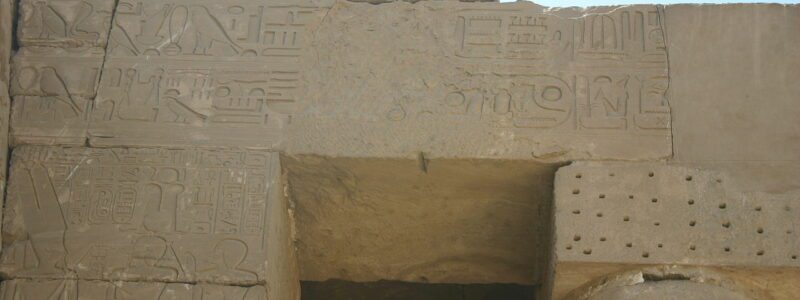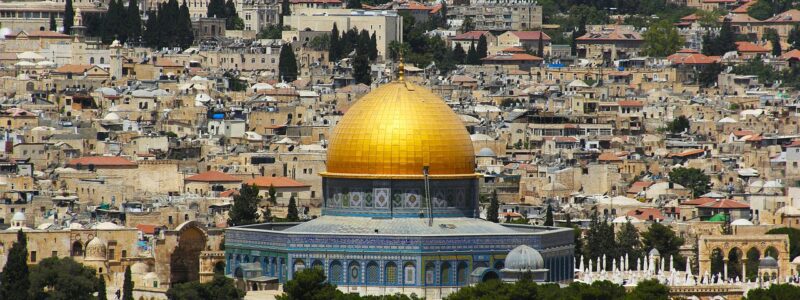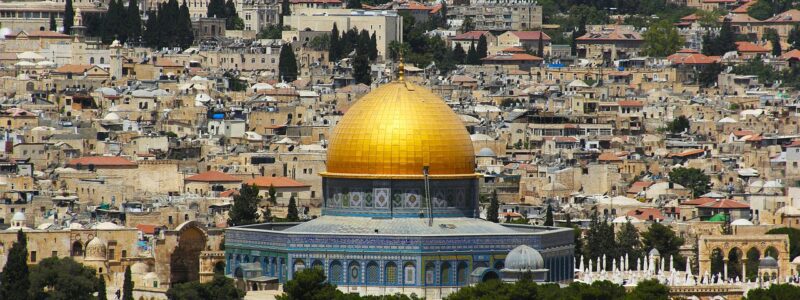Omri and the Moab Stele
The Moab Stele
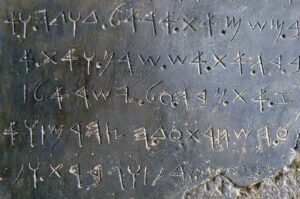
The Moab Stele
The Mesha or The Moab Stele presents one of the most remarkable affirmations of Biblical historicity. It is constructed out of black basalt (or volcanic rock) bearing an inscription by a ninth-century BC Moabite King named Mesha. The Moabites were a population group that lived near the Israelites in the Middle East on the eastern shore of the Dead Sea with its eastern border on the Ammon River. The Moabite capital was Dibon, and this ethnic group frequently conflicts with Israel. This conflict is discussed in Scripture and in multiple extra-Biblical sources.
Origin of Moab Ethnic Group
The Biblical origin of the Moab nation (Genesis 19:30-38) is through an incestuous relationship between Lot (the nephew of Abraham), and his oldest daughter. The daughter has lost her husband and mother in the destruction of Sodom and decided to have children through her father.
An interesting linguistic fact is a similarity between the Hebrew words mo’abi (“Moabite”) and me’abi (“from my father”) – likely no coincidence. Moabite women led the men of Israel into forgetting about the Exodus (Num 25;1-2) and Solomon into sin during his reign (1 Kings 11:10). King David was said to have killed two-thirds of Moabite captives es (2 Samuel 8:2), and the prophets Amos (Amos 2:1-2), Isaiah (Isa 15-16, Isa 25:10-12), Jeremiah (Jer 48) and Ezekiel (Ezek 25:8-11) all prophesy the destruction of the nation. This ill-fated decision produced a group of people often at war with Israel.
The Moabites were so disliked that children from an Israeli – Moabite union were not allowed into the assembly of Yahweh until ten generations had passed (Deut. 23:3)). However, this disdain for the Moabites is tempered in Ruth – a Moabite who eventually marries an Israelite and becomes an ancestor of King David and Christ.
The End of Moab
The Moabite civilization flourished through the intervening centuries until 582 BC when they were captured by the Babylonians and led into captivity (much like the remnants of Israel several years before)). The difference was that the Moabites assimilated into the Babylonian culture and are never heard from again; the Jewish nation largely remained separate from the Babylonians and retained their culture. The Persians eventually conquered the Babylonians and the Jewish community was permitted to return to their homeland – Jerusalem.
The land the Moabite nation left behind when conquered by the Babylonians was eventually settled by another group of people – the Nabataeans – who would eventually build the ancient city of Petra.
The Mesha Stele
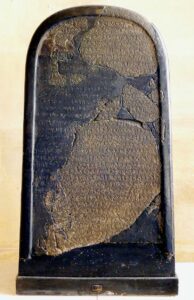
Mesha Stele – By Unknown artist – Mbzt 2012, CC BY 3.0, https://commons.wikimedia.org/w/index.php?curid=22090379
The Mesha Stele originally possessed Bedouins living east of the Jordan River. It came to the attention of F.A. Klein, a German missionary who heard about the stone while visiting. The Berlin Museum and the French Consulate in Jerusalem bid on the stone, demonstrating its value to the Bedouin. The Bedouins kept increasing their price, hoping to goad the eager bidders into a bidding war.
They were unable to reach a final price, and the Bedouins decided to break the stele into hundreds of pieces and distribute the pieces among themselves. To do this, they heated the stone by building a fire around it, and then poured cold water on it; eventually, it was split into about 1100 pieces. They were hoping to be able to sell the individual pieces and multiply their profits.
About 669 fragments were recovered several years later, comprising about two-thirds of the original stone. Fortunately, a paper mache impression had been made of the stele before its breaking, making reconstruction of the original inscription possible.
The Mesha stele was written about 850 BC as a memorial of the Moab victories in battle, especially regarding its victories over the nation of Israel. The stele is currently displayed in the Louvre Museum in Paris in its reconstructed form.
The Moab Threat
One of the major themes of the Old Testament is the need for Israel to remain a separate nation; it was not to intermarry with the surrounding ethnic groups, and individuals from those groups could only be assimilated into the Israeli population if they decided to adopt the culture and worship the Hebrew God.
The Moabites were an especial threat because their culture was similar to the Israelites in many ways. The language of the Moab Stele indicates it is very similar to ancient Hebrew – the two populations could probably have talked with each other without a translator.
This similarity in language and some aspects of culture seriously threatened the Israeli people’s identity. The danger was that Israel would assimilate into the Moabite culture, losing their identity. This would naturally have had devastating consequences in that Christ was to be a Jew, and if no Jews, what of Christ?
Likely this threat was why so many Jewish prophets railed against Moab and why descendants resulting from a marriage between these two populations would not be allowed into Hebrew settlements.
Description of Biblical Events
The stele portrays three historical events in the life of the Moab nation. The inscription is consistent with the Biblical narrative; several events, names, and places mentioned in the stele are also mentioned in the Bible.
Mesha is mentioned in the Bible in 1 Kings 3:4; “Now Mesha king of Moab was a sheep breeder, and he had to deliver to the king of Israel 100,000 lambs and the wool of 100,000 rams.” The Moab god Chemosh is also mentioned in multiple places in Scripture
Moab is described as subject to the Biblical King Omri of Israel (the father of Ahab) due to anger from the god Chemosh. The stele also mentioned many places in Israel, such as Nebo and Gad, that also appear in Scripture.
House of David
Time magazine reported on a discovery by a French scholar Andre Lemaitre who studied the stone for about seven years. Time notes,
The skeptics claim that King David never existed is not hard to defend. Last year, the French scholar Andre Lemaire reported a related “house of David” discovery in Biblical Archaeology Review. His subject was the Mesha stone (also known as the Moabite Stone), the most extensive inscription ever recovered from ancient Palestine. Found in 1868 at the ruins of biblical Dibon and later fractured, the basalt stone wound up in the Louvre, where Lemaire spent seven years studying it. His conclusion: the phrase “House of David” appears there as well. As with the Tel Dan fragment, this inscription comes from an enemy of Israel boasting of a victory – King Mesha of Moab, who figured in the Bible. Lemaitre had to reconstruct a missing letter to decode the wording, but if he’s right, there are now two 9th century references to David’s dynasty. (Time Magazine, December 18, 1995 Volume 146, No. 25).,
Summary
The Mesha Stele or Moab Stone is one of the most important relics of the ancient Middle East because it testifies to the interaction between two Biblical groups – the Israelites and the Moabites.
These two neighboring groups were frequently at war, and these wars are detailed in both Scriptures and the Moab Stele. What is remarkable is the similarity between the two accounts and the mentioning of several important Biblical characters in the text, especially a relatively minor Biblical King named Omri. He held power for about twelve years and is described in Scripture as more evil than all the kings before him. He was responsible for establishing the city of Samaria as the capital of Israel in opposition to Jerusalem and causing his people to worship there rather than the city established by God as the capital of Israel.

